Nikon L840 vs Olympus E-520
The Nikon Coolpix L840 and the Olympus E-520 are two digital cameras that were announced, respectively, in February 2015 and May 2008. The L840 is a fixed lens compact, while the E-520 is a DSLR. The cameras are based on a 1/2.3-inch (L840) and a Four Thirds (E-520) sensor. The Nikon has a resolution of 15.9 megapixels, whereas the Olympus provides 10 MP.
Below is an overview of the main specs of the two cameras as a starting point for the comparison.

Check L840 offers at
ebay.com

Check E-520 offers at
ebay.com
Going beyond this snapshot of core features and characteristics, what are the differences between the Nikon Coolpix L840 and the Olympus E-520? Which one should you buy? Read on to find out how these two cameras compare with respect to their body size, their imaging sensors, their shooting features, their input-output connections, and their reception by expert reviewers.
Body comparison
The side-by-side display below illustrates the physical size and weight of the Nikon L840 and the Olympus E-520. The two cameras are presented according to their relative size. Three consecutive perspectives from the front, the top, and the back are available. All width, height and depth measures are rounded to the nearest millimeter.
The L840 can be obtained in two different colors (black, red), while the E-520 is only available in black.
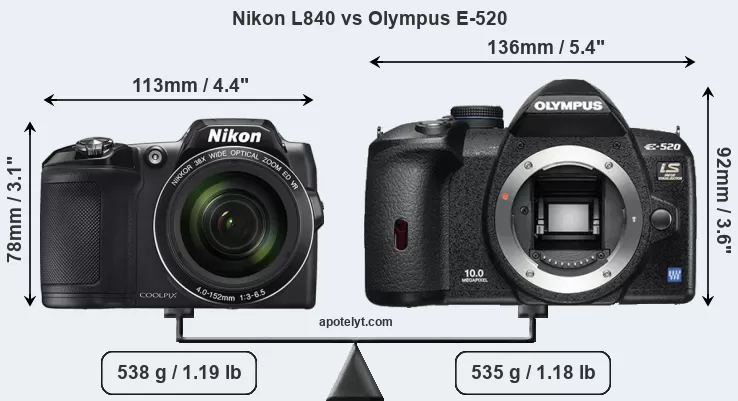
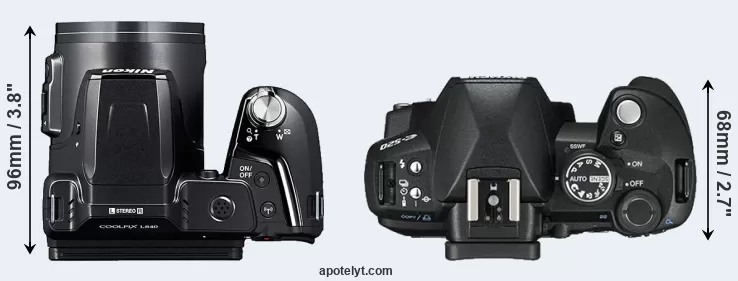
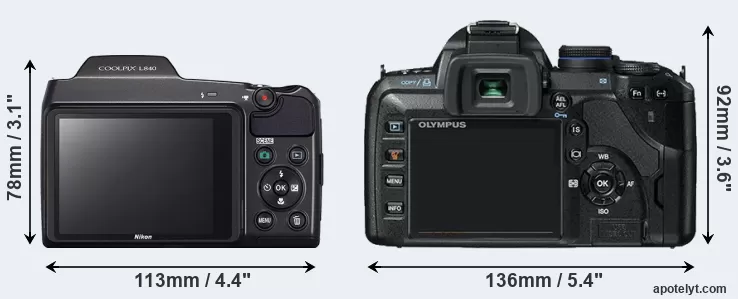
If the front view area (width x height) of the cameras is taken as an aggregate measure of their size, the Olympus E-520 is notably larger (42 percent) than the Nikon L840. In this context, it is worth noting that neither the L840 nor the E-520 are weather-sealed.
The above size and weight comparisons are to some extent incomplete and possibly misleading, as the L840 has a lens built in, whereas the E-520 is an interchangeable lens camera that requires a separate lens. Attaching the latter will add extra weight and bulk to the setup. You can compare the optics available for the E-520 and their specifications in the Four Thirds Lens Catalog.
The following table provides a synthesis of the main physical specifications of the two cameras and other similar ones. If you would like to visualize and compare a different camera combination, you can navigate to the CAM-parator app and make your selection from a broad list of cameras there.

| # | Camera Model |
Camera Width |
Camera Height |
Camera Depth |
Camera Weight |
Battery Life |
Weather Sealing |
Camera Launch |
Launch Price (USD) |
Street Price |
|
|---|---|---|---|---|---|---|---|---|---|---|---|
| 1. | Nikon L840 | 113 mm | 78 mm | 96 mm | 538 g | 590 | n | Feb 2015 | 299 | ebay.com | |
| 2. | Olympus E-520 | 136 mm | 92 mm | 68 mm | 535 g | 750 | n | May 2008 | 699 | ebay.com | |
| 3. | Canon SX530 | 120 mm | 82 mm | 92 mm | 442 g | 210 | n | Jan 2015 | 429 | ebay.com | |
| 4. | Canon SX520 | 120 mm | 82 mm | 92 mm | 441 g | 210 | n | Jul 2014 | 399 | ebay.com | |
| 5. | Canon SX60 | 128 mm | 93 mm | 114 mm | 650 g | 340 | n | Sep 2014 | 549 | ebay.com | |
| 6. | Leica X Typ 113 | 133 mm | 73 mm | 78 mm | 486 g | 350 | n | Sep 2014 | 2,295 | ebay.com | |
| 7. | Nikon B600 | 122 mm | 82 mm | 99 mm | 500 g | 280 | n | Jan 2019 | 349 | ebay.com | |
| 8. | Nikon B700 | 125 mm | 85 mm | 107 mm | 565 g | 350 | n | Feb 2016 | 499 | ebay.com | |
| 9. | Nikon B500 | 114 mm | 78 mm | 95 mm | 541 g | 600 | n | Jan 2016 | 299 | ebay.com | |
| 10. | Nikon P900 | 140 mm | 103 mm | 137 mm | 899 g | 360 | n | Mar 2015 | 599 | ebay.com | |
| 11. | Olympus E-600 | 130 mm | 94 mm | 60 mm | 535 g | 500 | n | Aug 2009 | 449 | ebay.com | |
| 12. | Olympus E-620 | 130 mm | 94 mm | 60 mm | 521 g | 500 | n | Feb 2009 | 699 | ebay.com | |
| 13. | Olympus E-420 | 130 mm | 91 mm | 53 mm | 440 g | 500 | n | Mar 2008 | 599 | ebay.com | |
| 14. | Olympus E-410 | 130 mm | 91 mm | 53 mm | 435 g | 500 | n | Mar 2007 | 699 | ebay.com | |
| 15. | Olympus E-510 | 136 mm | 92 mm | 68 mm | 538 g | 750 | n | Mar 2007 | 799 | ebay.com | |
| 16. | Sony HX80 | 102 mm | 58 mm | 36 mm | 245 g | 390 | n | Mar 2016 | 349 | ebay.com | |
| 17. | Sony H400 | 130 mm | 95 mm | 122 mm | 628 g | 300 | n | Feb 2014 | 319 | ebay.com | |
| Note: Measurements and pricing do not include easily detachable parts, such as add-on or interchangeable lenses or optional viewfinders. | |||||||||||
Any camera decision will obviously take relative prices into account. The manufacturer’s suggested retail prices give an idea on the placement of the camera in the maker’s lineup and the broader market. The L840 was launched at a lower price than the E-520, despite having a lens built in. Normally, street prices remain initially close to the MSRP, but after a couple of months, the first discounts appear. Later in the product cycle and, in particular, when the replacement model is about to appear, further discounting and stock clearance sales often push the camera price considerably down. Then, after the new model is out, very good deals can frequently be found on the pre-owned market.
Sensor comparison
The imaging sensor is at the core of digital cameras and its size is one of the main determining factors of image quality. A large sensor will generally have larger individual pixels that offer better low-light sensitivity, provide wider dynamic range, and have richer color-depth than smaller pixels in a sensor of the same technological generation. Moreover, a large sensor camera will give the photographer more control over depth-of-field in the image and, thus, the ability to better isolate a subject from the background. On the downside, larger sensors tend to be more expensive and lead to bigger and heavier cameras and lenses.
Of the two cameras under consideration, the Nikon L840 features a 1/2.3-inch sensor and the Olympus E-520 a Four Thirds sensor. The sensor area in the E-520 is 704 percent bigger. As a result of these sensor size differences, the cameras have a format factor of, respectively, 5.6 and 2.0. Both cameras feature a native aspect ratio (sensor width to sensor height) of 4:3.
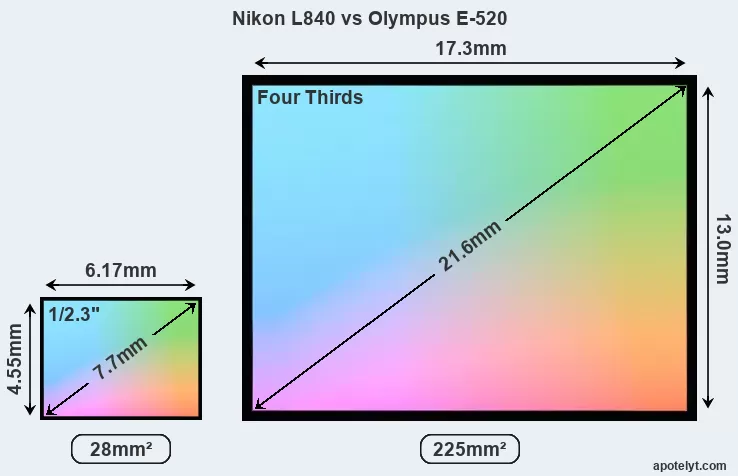
Despite having a smaller sensor, the Nikon L840 offers a higher resolution of 15.9 megapixels, compared with 10 MP of the Olympus E-520. This megapixels advantage comes at the cost of a higher pixel density and a smaller size of the individual pixel (with a pixel pitch of 1.33μm versus 4.74μm for the E-520). However, it should be noted that the L840 is much more recent (by 6 years and 9 months) than the E-520, and its sensor will have benefitted from technological advances during this time that make it possible to gather light more efficiently. Coming back to sensor resolution, it should be mentioned that the L840 has no anti-alias filter installed, so that it can capture all the detail its sensor resolves.
The resolution advantage of the Nikon L840 implies greater flexibility for cropping images or the possibility to print larger pictures. The maximum print size of the L840 for good quality output (200 dots per inch) amounts to 23 x 17.3 inches or 58.5 x 43.9 cm, for very good quality (250 dpi) 18.4 x 13.8 inches or 46.8 x 35.1 cm, and for excellent quality (300 dpi) 15.4 x 11.5 inches or 39 x 29.3 cm. The corresponding values for the Olympus E-520 are 18.2 x 13.7 inches or 46.3 x 34.7 cm for good quality, 14.6 x 10.9 inches or 37.1 x 27.8 cm for very good quality, and 12.2 x 9.1 inches or 30.9 x 23.2 cm for excellent quality prints.
The Nikon Coolpix L840 has a native sensitivity range from ISO 100 to ISO 6400. The corresponding ISO settings for the Olympus E-520 are ISO 100 to ISO 1600 (no boost).
Technology-wise, both cameras are equipped with CMOS (Complementary Metal–Oxide–Semiconductor) sensors. Both cameras use a Bayer filter for capturing RGB colors on a square grid of photosensors. This arrangement is found in most digital cameras.
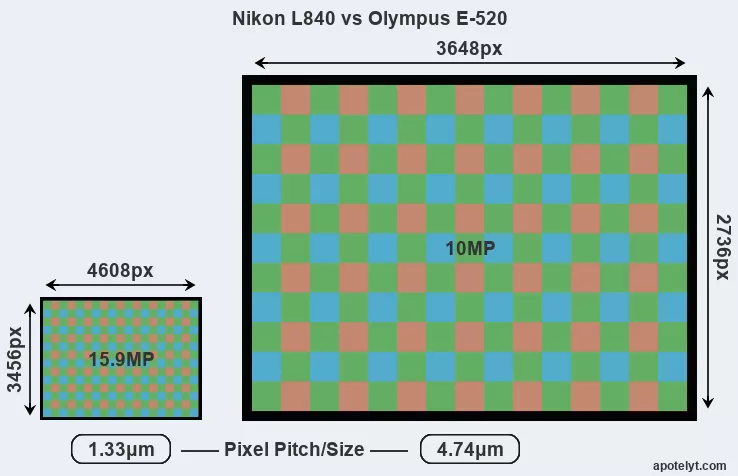
Consistent information on actual sensor performance is available from DXO Mark for many cameras. This service assesses and scores the color depth ("DXO Portrait"), dynamic range ("DXO Landscape"), and low-light sensitivity ("DXO Sports") of camera sensors, and also publishes an overall camera score. The table below summarizes the physical sensor characteristics and sensor quality findings and compares them across a set of similar cameras.

| # | Camera Model |
Sensor Class |
Resolution (MP) |
Horiz. Pixels |
Vert. Pixels |
Video Format |
DXO Portrait |
DXO Landscape |
DXO Sports |
DXO Overall |
|
|---|---|---|---|---|---|---|---|---|---|---|---|
| 1. | Nikon L840 | 1/2.3 | 15.9 | 4608 | 3456 | 1080/60i | 20.2 | 11.6 | 721 | 47 | |
| 2. | Olympus E-520 | Four Thirds | 10.0 | 3648 | 2736 | none | 21.4 | 10.4 | 548 | 55 | |
| 3. | Canon SX530 | 1/2.3 | 15.9 | 4608 | 3456 | 1080/30p | 20.2 | 11.6 | 712 | 47 | |
| 4. | Canon SX520 | 1/2.3 | 15.9 | 4608 | 3456 | 1080/30p | 20.1 | 11.5 | 672 | 46 | |
| 5. | Canon SX60 | 1/2.3 | 14.2 | 4608 | 3072 | 1080/60p | 19.2 | 10.8 | 127 | 39 | |
| 6. | Leica X Typ 113 | APS-C | 16.1 | 4928 | 3264 | 1080/30p | 23.6 | 12.8 | 1491 | 78 | |
| 7. | Nikon B600 | 1/2.3 | 15.9 | 4608 | 3456 | 1080/30p | 20.7 | 12.2 | 1095 | 52 | |
| 8. | Nikon B700 | 1/2.3 | 20.2 | 5184 | 3888 | 4K/30p | 20.4 | 11.8 | 818 | 48 | |
| 9. | Nikon B500 | 1/2.3 | 15.9 | 4608 | 3456 | 1080/60i | 20.3 | 11.7 | 810 | 48 | |
| 10. | Nikon P900 | 1/2.3 | 15.9 | 4608 | 3456 | 1080/60p | 20.2 | 11.6 | 727 | 47 | |
| 11. | Olympus E-600 | Four Thirds | 12.2 | 4032 | 3024 | none | 21.5 | 10.3 | 541 | 55 | |
| 12. | Olympus E-620 | Four Thirds | 12.2 | 4032 | 3024 | none | 21.3 | 10.3 | 536 | 55 | |
| 13. | Olympus E-420 | Four Thirds | 10.0 | 3648 | 2736 | none | 21.5 | 10.4 | 527 | 56 | |
| 14. | Olympus E-410 | Four Thirds | 10.0 | 3648 | 2736 | none | 21.1 | 10.0 | 494 | 51 | |
| 15. | Olympus E-510 | Four Thirds | 10.0 | 3648 | 2736 | none | 21.2 | 10.0 | 442 | 52 | |
| 16. | Sony HX80 | 1/2.3 | 18.0 | 4896 | 3672 | 1080/60p | 20.4 | 11.8 | 822 | 48 | |
| 17. | Sony H400 | 1/2.3 | 19.9 | 5152 | 3864 | 720/30p | 20.1 | 11.4 | 630 | 45 | |
| Note: DXO values in italics represent estimates based on sensor size and age. | |||||||||||
Many modern cameras are not only capable of taking still images, but can also record movies. The L840 indeed provides movie recording capabilities, while the E-520 does not. The highest resolution format that the L840 can use is 1080/60i.
Feature comparison
Apart from body and sensor, cameras can and do differ across a variety of features. For example, the E-520 has an optical viewfinder, which can be very useful when shooting in bright sunlight. In contrast, the L840 relies on live view and the rear LCD for framing. The table below summarizes some of the other core capabilities of the Nikon L840 and Olympus E-520 in connection with corresponding information for a sample of similar cameras.

| # | Camera Model |
Viewfinder (Type or 000 dots) |
Control Panel (yes/no) |
LCD Specifications (inch/000 dots) |
LCD Attach- ment |
Touch Screen (yes/no) |
Max Shutter Speed * |
Max Shutter Flaps * |
Built-in Flash (yes/no) |
Built-in Image Stab |
|
|---|---|---|---|---|---|---|---|---|---|---|---|
| 1. | Nikon L840 | none | n | 3.0 / 921 | tilting | n | 1/4000s | 7.4/s | Y | Y | |
| 2. | Olympus E-520 | optical | n | 2.7 / 215 | fixed | n | 1/4000s | 3.5/s | Y | Y | |
| 3. | Canon SX530 | none | n | 3.0 / 461 | fixed | n | 1/2000s | 1.6/s | Y | Y | |
| 4. | Canon SX520 | none | n | 3.0 / 461 | fixed | n | 1/2000s | 1.6/s | Y | Y | |
| 5. | Canon SX60 | 922 | n | 3.0 / 922 | swivel | n | 1/2000s | 6.4/s | Y | Y | |
| 6. | Leica X Typ 113 | optional | n | 3.0 / 920 | fixed | n | 1/2000s | 5.0/s | Y | n | |
| 7. | Nikon B600 | none | n | 3.0 / 921 | fixed | n | 1/4000s | 7.4/s | Y | Y | |
| 8. | Nikon B700 | 921 | n | 3.0 / 921 | swivel | n | 1/4000s | 5.0/s | Y | Y | |
| 9. | Nikon B500 | none | n | 3.0 / 921 | tilting | n | 1/4000s | 7.4/s | Y | Y | |
| 10. | Nikon P900 | 921 | n | 3.0 / 921 | swivel | n | 1/4000s | 7.0/s | Y | Y | |
| 11. | Olympus E-600 | optical | n | 2.7 / 230 | swivel | n | 1/4000s | 4.0/s | Y | Y | |
| 12. | Olympus E-620 | optical | n | 2.7 / 230 | swivel | n | 1/4000s | 4.0/s | Y | Y | |
| 13. | Olympus E-420 | optical | n | 2.7 / 215 | fixed | n | 1/4000s | 3.5/s | Y | n | |
| 14. | Olympus E-410 | optical | n | 2.5 / 215 | fixed | n | 1/4000s | 3.0/s | Y | n | |
| 15. | Olympus E-510 | optical | n | 2.5 / 215 | fixed | n | 1/4000s | 3.0/s | Y | Y | |
| 16. | Sony HX80 | 638 | n | 3.0 / 922 | tilting | n | 1/2000s | 10.0/s | Y | Y | |
| 17. | Sony H400 | 210 | n | 3.0 / 460 | fixed | n | 1/2000s | 0.7/s | Y | Y | |
| Note: *) Information refers to the mechanical shutter, unless the camera only has an electronic one. | |||||||||||
The L840 writes its imaging data to SDXC cards, while the E-520 uses Compact Flash or xD Picture cards. The E-520 features dual card slots, which can be very useful in case a memory card fails. In contrast, the L840 only has one slot.
Connectivity comparison
For some imaging applications, the extent to which a camera can communicate with its environment can be an important aspect in the camera decision process. The table below provides an overview of the connectivity of the Nikon Coolpix L840 and Olympus E-520 and, in particular, the interfaces the cameras (and selected comparators) provide for accessory control and data transfer.

| # | Camera Model |
Hotshoe Port |
Internal Mic / Speaker |
Microphone Port |
Headphone Port |
HDMI Port |
USB Port |
WiFi Support |
NFC Support |
Bluetooth Support |
|
|---|---|---|---|---|---|---|---|---|---|---|---|
| 1. | Nikon L840 | - | stereo / mono | - | - | micro | 2.0 | Y | Y | - | |
| 2. | Olympus E-520 | Y | - / - | - | - | - | 2.0 | - | - | - | |
| 3. | Canon SX530 | - | stereo / mono | - | - | mini | 2.0 | Y | Y | - | |
| 4. | Canon SX520 | - | stereo / mono | - | - | mini | 2.0 | - | - | - | |
| 5. | Canon SX60 | Y | stereo / mono | Y | - | mini | 2.0 | Y | Y | - | |
| 6. | Leica X Typ 113 | Y | stereo / mono | - | - | mini | 2.0 | - | - | - | |
| 7. | Nikon B600 | - | stereo / mono | - | - | micro | 2.0 | Y | - | Y | |
| 8. | Nikon B700 | - | stereo / mono | - | - | micro | 2.0 | Y | Y | Y | |
| 9. | Nikon B500 | - | stereo / mono | - | - | micro | 2.0 | Y | Y | Y | |
| 10. | Nikon P900 | - | stereo / mono | - | - | micro | 2.0 | Y | Y | - | |
| 11. | Olympus E-600 | Y | - / - | - | - | - | 2.0 | - | - | - | |
| 12. | Olympus E-620 | Y | - / - | - | - | - | 2.0 | - | - | - | |
| 13. | Olympus E-420 | Y | - / - | - | - | - | 2.0 | - | - | - | |
| 14. | Olympus E-410 | Y | - / - | - | - | - | 2.0 | - | - | - | |
| 15. | Olympus E-510 | Y | - / - | - | - | - | 2.0 | - | - | - | |
| 16. | Sony HX80 | - | stereo / mono | - | - | micro | 2.0 | Y | Y | - | |
| 17. | Sony H400 | - | mono / mono | - | - | micro | 2.0 | Y | - | - |
It is notable that the L840 offers wifi support, while the E-520 does not. Wifi can be a very convenient means to transfer image data to an off-camera location.
Both the L840 and the E-520 have been discontinued, but can regularly be found used on ebay. The L840 was replaced by the Nikon B500, while the E-520 does not have a direct successor. Further information on the features and operation of the L840 and E-520 can be found, respectively, in the Nikon L840 Manual (free pdf) or the online Olympus E-520 Manual.
Review summary
So how do things add up? Is there a clear favorite between the Nikon L840 and the Olympus E-520? Which camera is better? The listing below highlights the relative strengths of the two models.

Reasons to prefer the Nikon Coolpix L840:
- More detail: Offers more megapixels (15.9 vs 10MP) with a 26% higher linear resolution.
- Maximized detail: Lacks an anti-alias filter to exploit the sensor's full resolution potential.
- Broader imaging potential: Can record not only still images but also 1080/60i movies.
- Larger screen: Has a bigger rear LCD (3.0" vs 2.7") for image review and settings control.
- More detailed LCD: Has a higher resolution rear screen (921k vs 215k dots).
- More flexible LCD: Has a tilting screen for odd-angle shots in landscape orientation.
- Faster burst: Shoots at higher frequency (7.4 vs 3.5 flaps/sec) to capture the decisive moment.
- Ready to shoot: Comes with a built-in lens, while the E-520 requires a separate lens.
- More compact: Is smaller (113x78mm vs 136x92mm) and thus needs less room in the bag.
- Easier file upload: Has wifi built in for automatic backup or image transfer to the web.
- Easier device pairing: Supports NFC for fast wireless image transfer over short distances.
- More affordable: Was introduced at a lower price, despite coming with a built-in lens.
- More modern: Reflects 6 years and 9 months of technical progress since the E-520 launch.

Advantages of the Olympus E-520:
- Better moiré control: Has an anti-alias filter to avoid artificial patterns to appear in images.
- Better image quality: Features bigger pixels on a larger sensor for higher quality imaging.
- Richer colors: The pixel size advantage translates into images with better, more accurate colors.
- More dynamic range: Larger pixels capture a wider spectrum of light and dark details.
- Better low-light sensitivity: Larger pixels means good image quality even under poor lighting.
- Easier framing: Has an optical viewfinder for image composition and settings control.
- More flexible: Makes it possible to change lenses and thus to use specialty optics.
- Longer lasting: Gets more shots (750 versus 590) out of a single battery charge.
- Better lighting: Features a hotshoe and can thus hold and trigger an external flash gun.
- Greater peace of mind: Features a second card slot as a backup in case of memory card failure.
- More heavily discounted: Has been around for much longer (launched in May 2008).
If the number of relative strengths (bullet points above) is taken as a guide, the L840 emerges as the winner of the contest (13 : 11 points). However, the pertinence of the various camera strengths will differ across photographers, so that you might want to weigh individual camera traits according to their importance for your own imaging needs before making a camera decision. A professional wedding photographer will view the differences between cameras in a way that diverges from the perspective of a travel photog, and a person interested in cityscapes has distinct needs from a macro shooter. Hence, the decision which camera is best and worth buying is often a very personal one.
How about other alternatives? Do the specifications of the Nikon L840 and the Olympus E-520 place the cameras among the top in their class? Find out in the latest Best Superzoom Camera and Best DSLR Camera listings whether the two cameras rank among the cream of the crop.
In any case, while the comparison of the spec-sheets of cameras can offer a general idea of their imaging potential, it remains incomplete and does no justice, for example, to the way the L840 or the E-520 perform in practice. At times, user reviews, such as those published at amazon, address these issues in a useful manner, but such feedback is on many occasions incomplete, inconsistent, and unreliable.
Expert reviews
This is where reviews by experts come in. The table below provides a synthesis of the camera assessments of some of the best known photo-gear review sites (amateurphotographer [AP], cameralabs [CL], digitalcameraworld [DCW], dpreview [DPR], ephotozine [EPZ], photographyblog [PB]). As can be seen, the professional reviewers agree in many cases on the quality of different cameras, but sometimes their assessments diverge, reinforcing the earlier point that a camera decision is often a very personal choice.

| # | Camera Model |
AP score |
CL score |
DCW score |
DPR score |
EPZ score |
PB score |
Camera Launch |
Launch Price (USD) |
Street Price |
|
|---|---|---|---|---|---|---|---|---|---|---|---|
| 1. | Nikon L840 | .. | + + | .. | .. | 3.5/5 | 4/5 | Feb 2015 | 299 | ebay.com | |
| 2. | Olympus E-520 | .. | 87/100 | .. | + + | 4.5/5 | 4.5/5 | May 2008 | 699 | ebay.com | |
| 3. | Canon SX530 | .. | + + | .. | .. | 4/5 | 4/5 | Jan 2015 | 429 | ebay.com | |
| 4. | Canon SX520 | .. | + | .. | .. | 3.5/5 | 3.5/5 | Jul 2014 | 399 | ebay.com | |
| 5. | Canon SX60 | 3/5 | + + | .. | 75/100 | 4/5 | 4.5/5 | Sep 2014 | 549 | ebay.com | |
| 6. | Leica X Typ 113 | 3.5/5 | .. | .. | .. | 3.5/5 | 4/5 | Sep 2014 | 2,295 | ebay.com | |
| 7. | Nikon B600 | .. | + | .. | .. | 3.5/5 | 3/5 | Jan 2019 | 349 | ebay.com | |
| 8. | Nikon B700 | .. | + | .. | .. | 4/5 | 4/5 | Feb 2016 | 499 | ebay.com | |
| 9. | Nikon B500 | .. | + | .. | .. | 4/5 | 3.5/5 | Jan 2016 | 299 | ebay.com | |
| 10. | Nikon P900 | .. | .. | .. | 77/100 | 4/5 | 4/5 | Mar 2015 | 599 | ebay.com | |
| 11. | Olympus E-600 | .. | .. | .. | .. | .. | 4.5/5 | Aug 2009 | 449 | ebay.com | |
| 12. | Olympus E-620 | 3/5 | 88/100 | .. | 72/100 | 4.5/5 | 5/5 | Feb 2009 | 699 | ebay.com | |
| 13. | Olympus E-420 | .. | 85/100 | .. | + + | 4/5 | 4.5/5 | Mar 2008 | 599 | ebay.com | |
| 14. | Olympus E-410 | .. | 86/100 | .. | + + | 4/5 | 4.5/5 | Mar 2007 | 699 | ebay.com | |
| 15. | Olympus E-510 | .. | 89/100 | .. | + + | 3.5/5 | 4.5/5 | Mar 2007 | 799 | ebay.com | |
| 16. | Sony HX80 | .. | .. | .. | .. | .. | .. | Mar 2016 | 349 | ebay.com | |
| 17. | Sony H400 | .. | o | .. | .. | 3.5/5 | 3.5/5 | Feb 2014 | 319 | ebay.com | |
| Note: (+ +) highly recommended; (+) recommended; (o) reviewed; (..) not available. | |||||||||||
The above review scores should be interpreted with care, though. The ratings were established in reference to similarly priced cameras that were available in the market at the time of the review. A score, therefore, has to be seen in close connection to the price and market introduction time of the camera, and rating-comparisons among cameras that span long time periods or concern very differently equipped models make little sense. Also, kindly note that some of the listed sites have over time developped their review approaches and their reporting style.

Check L840 offers at
ebay.com

Check E-520 offers at
ebay.com
Other camera comparisons
Did this review help to inform your camera decision process? In case you would like to check on the differences and similarities of other camera models, just use the search menu below. As an alternative, you can also directly jump to any one of the listed comparisons that were previously generated by the CAM-parator tool.
- Canon M100 vs Olympus E-520
- Canon T5i vs Olympus E-520
- Kodak S-1 vs Olympus E-520
- Nikon D850 vs Olympus E-520
- Nikon L840 vs Panasonic FZ2000
- Nikon L840 vs Panasonic G1
- Nikon L840 vs Panasonic GX1
- Nikon L840 vs Pentax MX-1
- Nikon L840 vs Ricoh GR
- Nikon L840 vs Sony A7S II
- Olympus E-520 vs Panasonic FT7
- Olympus E-520 vs Sony A6300
Specifications: Nikon L840 vs Olympus E-520
Below is a side-by-side comparison of the specs of the two cameras to facilitate a quick review of their differences and common features.
| Camera Model | Nikon L840 | Olympus E-520 |
|---|---|---|
| Camera Type | Fixed lens compact camera | Digital single lens reflex |
| Camera Lens | 22.5-855mm f/3.0-6.5 | Four Thirds lenses |
| Launch Date | February 2015 | May 2008 |
| Launch Price | USD 299 | USD 699 |
| Sensor Specs | Nikon L840 | Olympus E-520 |
| Sensor Technology | CMOS | CMOS |
| Sensor Format | 1/2.3" Sensor | Four Thirds Sensor |
| Sensor Size | 6.17 x 4.55 mm | 17.3 x 13.0 mm |
| Sensor Area | 28.0735 mm2 | 224.9 mm2 |
| Sensor Diagonal | 7.7 mm | 21.6 mm |
| Crop Factor | 5.6x | 2.0x |
| Sensor Resolution | 15.9 Megapixels | 10 Megapixels |
| Image Resolution | 4608 x 3456 pixels | 3648 x 2736 pixels |
| Pixel Pitch | 1.33 μm | 4.74 μm |
| Pixel Density | 56.73 MP/cm2 | 4.44 MP/cm2 |
| Moiré control | no AA filter | Anti-Alias filter |
| Movie Capability | 1080/60i Video | no Video |
| ISO Setting | 100 - 6,400 ISO | 100 - 1,600 ISO |
| DXO Sensor Quality (score) | .. | 55 |
| DXO Color Depth (bits) | .. | 21.4 |
| DXO Dynamic Range (EV) | .. | 10.4 |
| DXO Low Light (ISO) | .. | 548 |
| Screen Specs | Nikon L840 | Olympus E-520 |
| Viewfinder Type | no viewfinder | Optical viewfinder |
| Viewfinder Field of View | 95% | |
| Viewfinder Magnification | 0.46x | |
| LCD Framing | Live View | Live View |
| Rear LCD Size | 3.0inch | 2.7inch |
| LCD Resolution | 921k dots | 215k dots |
| LCD Attachment | Tilting screen | Fixed screen |
| Shooting Specs | Nikon L840 | Olympus E-520 |
| Focus System | Contrast-detect AF | Phase-detect AF |
| Continuous Shooting | 7.4 shutter flaps/s | 3.5 shutter flaps/s |
| Image Stabilization | Lens-based stabilization | In-body stabilization |
| Fill Flash | Built-in Flash | Built-in Flash |
| Storage Medium | SDXC cards | CF or XD cards |
| Single or Dual Card Slots | Single card slot | Dual card slots |
| Connectivity Specs | Nikon L840 | Olympus E-520 |
| External Flash | no Hotshoe | Hotshoe |
| USB Connector | USB 2.0 | USB 2.0 |
| HDMI Port | micro HDMI | no HDMI |
| Wifi Support | Wifi built-in | no Wifi |
| Near-Field Communication | NFC built-in | no NFC |
| Body Specs | Nikon L840 | Olympus E-520 |
| Battery Type | Nikon 4xAA | Olympus BLM-1 |
| Battery Life (CIPA) | 590 shots per charge | 750 shots per charge |
| Body Dimensions |
113 x 78 x 96 mm (4.4 x 3.1 x 3.8 in) |
136 x 92 x 68 mm (5.4 x 3.6 x 2.7 in) |
| Camera Weight | 538 g (19.0 oz) | 535 g (18.9 oz) |

Check L840 offers at
ebay.com

Check E-520 offers at
ebay.com
Did you notice an error on this page? If so, please get in touch, so that we can correct the information.

